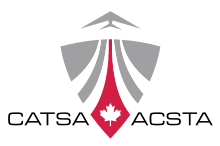Canadian Air Transport Security Authority
The Canadian Air Transport Security Authority (CATSA; French: Administration canadienne de la sûreté du transport aérien) is the Canadian Crown Corporation responsible for security screening of people and baggage and the administration of identity cards at the 89 designated airports in Canada. CATSA is answerable to Transport Canada and reports to the Government of Canada through the Minister of Transport.[1]
 | |
| Agency overview | |
|---|---|
| Formed | April 1, 2002 |
| Jurisdiction | Federal government of Canada |
| Headquarters | Sun Life Financial Centre, 99 Bank Street, Ottawa, Ontario |
| Employees | 390 (2008) |
| Minister responsible | |
| Agency executives |
|
| Website | CATSA |
Constitution
The Canadian Air Transport Security Authority was officially formed April 1, 2002, following the terrorist attacks on September 11, 2001 in the United States. After September 11, 2001, the Government of Canada took responsibility for airport screening which, until then, was the responsibility of the airlines as per direction from Transport Canada.[1] The Canadian Air Transport Security Authority Act (Budget Implementation Act, 2001) provides additional security requirements as prescribed under the Aeronautics Act.
CATSA shares responsibility for civil aviation security with several federal government departments and agencies, air carriers and airport operators. Transport Canada is Canada's designated national civil aviation security regulator, under the standards established by the International Civil Aviation Organization (ICAO).
CATSA contracts screening services to private security companies. There were 5,570 screening officers across Canada in 2013–2014, and 53.9 million passengers screened.[2]
Controversy
CATSA has been implicated in the past by the Privacy Commissioner of Canada for collecting non-aviation security information from the traveling public. For example, a domestic traveler with large sums of cash (not illegal) has in the past, been reported by CATSA to the local police force. CATSA also violates their own protocol by allowing employees to bring mobile phones and the use of CCTVs in the full body scan rooms. Of the 10,400 reported incidents in CATSA's databases at the time of the audit, more than half had nothing to do with aviation security.[3]
List of former heads of CATSA
Past heads of CATSA have had law enforcement background. Both Duchesneau and McGarr served with the Montreal Urban Community Police Service (SPCUM). Watt is a former Canadian Forces officer and once Commander of the Royal Canadian Air Force.
- Jacques Duchesneau 2002-2008
- Kevin McGarr 2008-12 [4]
- Angus Watt 2012-2017
- Michael Saunders 2017–Present
Interesting fact, in its current offices there is a boardroom named after each of CATSA's previous CEO's as well as other influential figures in Canadian aviation history.
References
- Security, Government of Canada, Transport Canada, Safety and Security, Aviation. "Canadian Air Transport Security Authority (CATSA) Review". www.tc.gc.ca.
- "CATSA Annual Report 2014" (PDF). Archived from the original (PDF) on 2014-10-26. Retrieved 2014-10-26.
- "RCMP, airport security agency breaching Canadians' privacy rights, watchdog". nationalpost.com. 17 November 2011.
- http://www.marketwired.com/press-release/canadian-air-transport-security-authority-917784.htm